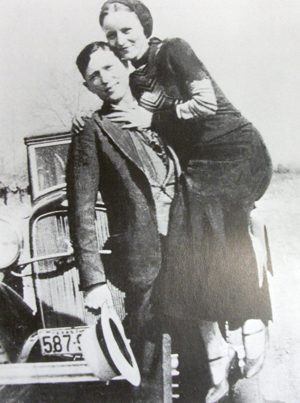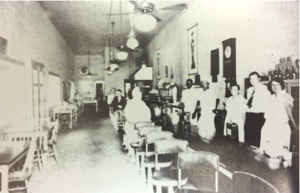
Clyde Barrow and Bonnie Parker before the law caught up with them.
Photo from History of the World in Photographs.
A LITTLE PIECE OF HISTORY | By Joan Frances –
History is filled with fascinating stories of the choices people made to survive in difficult times providing engaging biographies and dramatic stories of individuals doing whatever they could to survive, even if it was breaking the law. During the 1930s, Americans suffered financial losses from the Great Depression. This was considered the lawless decade when desperate men turned to breaking the law in order to line their pockets and wallets. Gangsters such as John Dillinger, Al Capone and Bugsy Siegel filled the headlines with deadly deeds. One of the most enticing stories audiences are forever enthralled with is Bonnie and Clyde. This infamous couple, nationally hunted for robbing banks, faced a tragic end, but their story lives forever, and Rosenberg has a piece of this history.
Clyde Barrow and Bonnie Parker met at a mutual friend’s house in west Dallas in January 1930. Barrow already had a police record for stealing cars, and within two months after meeting Parker, he served time in jail for burglary and theft. Parker agreed to smuggle a gun to him in prison, enabling him to escape. The law caught up with Barrow again, and after two years, he was paroled for good behavior. He returned to Parker and to a life of crime.
For four years, the Barrow gang robbed less than 15 banks and usually retrieved very little – at one bank only $80. Most of the successful robberies were by Barrow and Raymond Hamilton. Parker would drive the getaway car or wait at a hideout for them to return. The media exaggerated their story, promoting them as a romantic couple in stylish clothes and no fear of police, living a life of luxury on the run. Newspapers glamorized the exploits, and the public imagined them as Depression-era Robin Hoods. Their faces were everywhere, so they were constantly on the run. Barrow vowed never to return to prison, and he killed 14 lawmen in the four years he was robbing banks. The sensational stories recalled that the couple released more people than they hurt. In several instances, Barrow gave unharmed victims money to get home.

Clyde Barrow and Bonnie Parker were seen at The Eagle Café in Historic Downtown Rosenberg.
Photo from Images of America: Historic Downtown Rosenberg.
In 1934, a few months before that fateful day, Parker and Barrow drove up to the Eagle Café and Hotel on the corner of Main Street and Avenue F in Rosenberg. Parker was a tiny woman, four feet ten inches tall and between 85 and 90 pounds with yellow, naturally curly hair and steel blue eyes. Barrow was a handsome man with dark wavy hair, dancing brown eyes and a charming smile. Because of the extensive newspaper stories recounting their escapades, when they walked into the café, they were immediately recognized by Carl Turicchi, who waited on them. A hush came over the café as patrons studied these two strangers who were as famous as any movie star at the time. Sensing the public awareness, they left their car running outside, sat down, quietly ordered their food, ate and never looked up. No one called the police. No one said a word until they left. Barrow left a big tip.
Early death seems to preserve the memory of famous people, especially criminals. On May 23, 1934, the Dallas County Police meticulously orchestrated a stakeout. Parker and Barrow slowed to help a friend’s father with a flat tire and were ambushed by gunfire. “The long chase was over,” Emma Parker, Bonnie’s mother, later wrote. “The law had won. Bonnie and Clyde would never stand the world off again, two against death, for death had overtaken them at last.”